Warmsworth
Warmsworth is a village and civil parish in the Metropolitan Borough of Doncaster in South Yorkshire, England. It had a population of 3,855 in 2001[1] and 3,887 at time of the 2011 Census.[2] The village lies along the A1(M) Doncater Bypass and the A630. The River Don runs adjacent to Warmsworth, as well as the train line from Doncaster to Sheffield.
| Warmsworth | |
|---|---|
 Warmsworth Hall | |
 Warmsworth Location within South Yorkshire | |
| Population | 3,887 (2011 Census) |
| Civil parish |
|
| Metropolitan borough |
|
| Metropolitan county | |
| Region | |
| Country | England |
| Sovereign state | United Kingdom |
| Post town | DONCASTER |
| Postcode district | DN4 |
| Dialling code | 01302 |
| Police | South Yorkshire |
| Fire | South Yorkshire |
| Ambulance | Yorkshire |
| Website | Warmsworth Parish Council |
Warmsworth is bounded by Doncaster and the civil parishes of Sprotbrough, Edlington, Conisbrough, Cadeby and Balby. It lies 3.9 miles (6.3 km) from the centre of Doncaster. Warmsworth is within the catchment area for Warmsworth Primary School and Sir Thomas Wharton Academy.
History
Until 1974, Warmsworth was part of the West Riding of Yorkshire, when it then became part of the new county of South Yorkshire. Warmsworth was mentioned in the 11th century Domesday Book, a detailed survey and valuation of all the land held by the King William I and his chief tenants. At this time it was recorded as Wemesford. The name gradually changed to Wormsford, and then to the present day Warmsworth. It has been suggested that "ford" indicated that it was close to the river's edge, and the "Wemes" or "Worm" meant the most sheltered site in that area.[3]
The church is a rectory, dedicated to St Peter, in the deanery of Doncaster.[4] Also known as The White Church, it was consecrated in 1942 to replace a small early 19th-century church on a different site. The church was designed after a period which the rector had spent in California, and his experiences there influenced the whitewashed brick appearance of the building.[5]
Warmsworth was the home of the Quaker Thomas Aldham, who was instrumental, with George Fox, in founding the nearby Balby meeting (congregation).[6] The parish included Carr House, where Leonard Childers bred the famous racehorse Flying Childers.
Warmsworth Hall
Warmsworth Hall is a Grade II* listed building built in 1702–1703 for John Battie II. It is a smaller version of Belton House near Grantham, built to a compact H-plan. It remained a dwelling until the 1950s, when it became the headquarters of British Ropes Ltd, and later a hotel.[7]
Dolomite Quarry
Next to the village is a dolomite limestone quarry operated by Sibelco. It is the only site in the region producing industrial minerals on a major scale.[8]
References
- Office for National Statistics: Census 2001: Parish Headcounts: Doncaster Retrieved 2009-08-27
- "Civil Parish population 2011". Neighbourhood Statistics. Office for National Statistics. Retrieved 9 March 2016.
- A Short History of Warmsworth Retrieved 17 September 2018.
- The Ancient Parish of WARMSWORTH Retrieved 2010-11-29
- A Yorkshire Town: The Making of Doncaster Retrieved 17 September 2018.
- History of Doncaster Friends Retrieved 30 September 2011.
- A Yorkshire Town: The Making of Doncaster Retrieved 17 September 2018
- The Quarrying of Magnesian Limestone for Aggregate in the Yorkshire and Humber Region Retrieved 17 September 2018